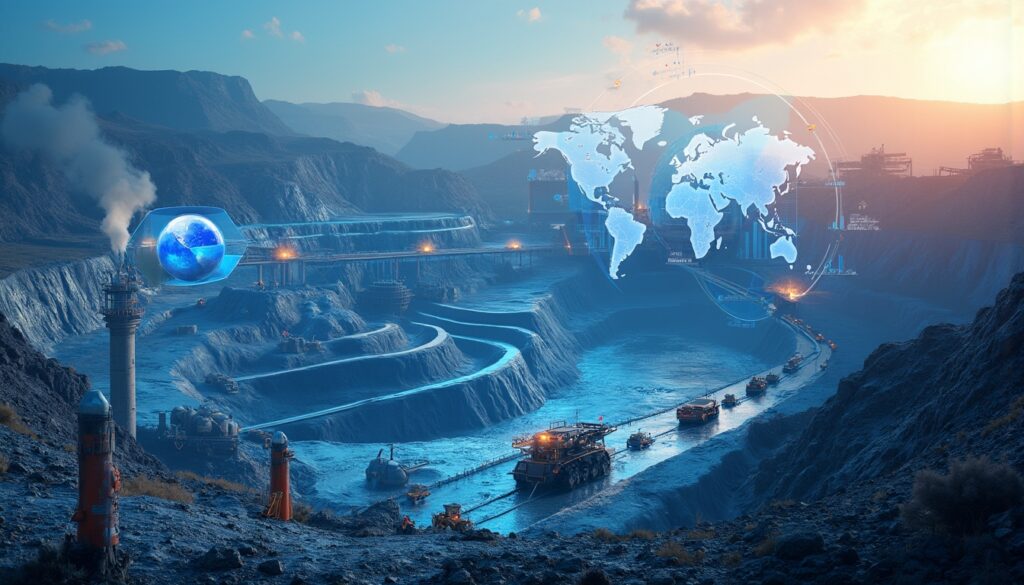Cobalt is a silvery-blue metallic element that has become increasingly crucial in our modern technological landscape. Projections indicate that demand from the electric vehicle revolution will ensure sustained importance for the World's Biggest Cobalt Mining Companies. Deposits occur naturally alongside copper and nickel, and the metal is essential in the production of lithium-ion batteries powering EVs and portable electronics.
The metal plays a critical role in extending battery life by 15-20% while significantly enhancing thermal stability. This enhanced stability prevents overheating and reduces fire risks. These factors contribute to high-density energy storage applications and demonstrate mining's pivotal role in the clean energy transition (mining's pivotal role in the clean energy transition).
The global transition to clean energy has dramatically intensified cobalt demand. Although manufacturers are reducing cobalt content to offset supply concerns and costs, the element remains indispensable. As noted by one industry analyst, the electrification push across sectors is driving unprecedented demand for battery materials.
A concentrated supply, primarily from the Democratic Republic of Congo (DRC), creates supply chain vulnerabilities. The DRC is responsible for around 70% of global cobalt reserves, making it a linchpin in the industry. The dominance of a few regions further accentuates the significance of the World's Biggest Cobalt Mining Companies in global markets.
Recent reports from top cobalt producing countries highlight the strategic importance of this metal. Prices have experienced significant volatility, fluctuating between $30,000 and $95,000 per metric tonne. Despite alternatives undergoing research, advanced batteries still depend on cobalt for energy density and cycle life.
How Is Cobalt Extracted and Processed?
Cobalt mining companies use both underground and open-pit methods based on ore deposit characteristics. Most cobalt is obtained as a by-product of copper and nickel mining, accounting for approximately 98% of global production.
After extraction, cobalt-bearing ore is crushed and ground to liberate valuable minerals. The ore then undergoes beneficiation through flotation processes, applying mineral separation techniques such as flotation to separate the cobalt-bearing minerals from waste material.
The resulting concentrate exhibits a significantly higher cobalt content, rendering further processing economically viable. Several companies have developed proprietary methods to optimise cobalt recovery. For instance, Sherritt International has pioneered innovative hydrometallurgical processes that minimise environmental impact.
In many cases, the processing entails leaching with sulfuric acid to dissolve cobalt, followed by solvent extraction and electrowinning. Some advanced facilities use solar evaporation ponds and precipitation to further refine the material. These operations illustrate the technological complexity involved in cobalt processing.
Mining efficiency varies significantly. Major producers such as Glencore achieve recovery rates above 85% in the DRC, while smaller operations may only recover 60-70%. Cost implications range from $20,000 to $45,000 per tonne, depending on scale and technological sophistication.
Investments in processing facilities can scale from $500 million to $2 billion. These state-of-the-art operations are strategically located to enhance mineral recovery, reduce transportation expenses, and lower environmental impacts.
Who Are the Top 5 Cobalt Mining Companies Globally?
The global cobalt mining landscape is dominated by diversified companies that extract cobalt alongside other minerals. These industry giants have cemented their positions through strategic acquisitions and operational excellence.
-
Glencore (Switzerland) produces roughly 26,800 tonnes annually, representing about 20% of the global supply. Its operations in the DRC, including the Mutanda and Katanga mines, drive its dominance. Glencore is actively increasing capacity while meeting responsible sourcing standards.
-
BHP Group (Australia) extracts cobalt primarily as part of its Nickel West operations in Western Australia. Its integrated mining-to-market model captures value across the supply chain. Recent investments of $50 million aim to uncover new cobalt-bearing deposits.
-
Rio Tinto (UK) produces around 2,500 tonnes from the Kennecott copper mine in Utah. The company has invested $1.5 billion to secure operations until 2032, which underpins its future supply. This strategy underlines its overall revenue contribution from cobalt.
-
Vale S.A. (Brazil) operates in 30 countries and extracts cobalt from various regions including Canada, Indonesia, and New Caledonia. An integrated railway system provides Vale with competitive transport advantages from remote sites to processing plants.
-
Anglo American (UK) produces approximately 2,300 tonnes annually through its platinum group metals operations in South Africa. Their recent $5.1 billion acquisition of Sirius Minerals underscores a commitment to advancing specialty metals extraction.
These companies collectively rank among the World's Biggest Cobalt Mining Companies and influence market trends significantly. Investors and industry observers closely monitor their operations to gauge future market shifts.
What Role Do Chinese Companies Play in the Cobalt Market?
Chinese mining companies have emerged as dominant players in the global cobalt supply chain. Their strategic investments, particularly in the DRC, have reshaped market dynamics. CMOC Group (formerly China Molybdenum) now stands as the most significant Chinese operator in this sector.
CMOC operates the Tenke Fungurume copper-cobalt mine in the DRC, one of the largest and highest-grade deposits. The operation produces around 18,600 tonnes of cobalt annually, contributing roughly 14% of global supply. A landmark $2.65 billion acquisition in 2016 transformed the market landscape.
The company has announced expansion plans that target an increase to 30,000 tonnes annually. This ambitious target is bolstered by adjacent deposit development and processing upgrades. Industry estimates predict that these projects will exceed $2.5 billion in investments over the next five years.
Beyond primary production, Chinese companies control nearly 80% of global cobalt refining capacity, according to CRU Group research. This downstream integration grants Chinese firms substantial influence over industry pricing and product specifications.
Significant investments in battery-grade processing facilities have aligned with China’s goal to dominate the EV market. These facilities are crucial for converting raw ore into high-quality materials, underscoring the strategic importance of the World's Biggest Cobalt Mining Companies.
The Belt and Road Initiative further strengthens China’s hold on the supply chain by improving infrastructure in resource-rich African nations. These endeavours solidify preferential access to critical cobalt reserves.
How Are North American Companies Competing in the Cobalt Sector?
North American companies encounter unique challenges due to the DRC’s dominance of cobalt reserves. Nonetheless, they have established vital positions through technological innovation and strategic partnerships.
Freeport-McMoRan (US) operates copper-cobalt mines in the DRC. Despite its divestment of several Congolese assets, the company maintains significant strategic production. Investments in a state-of-the-art Finnish refinery enable Freeport to produce battery-grade cobalt.
Wheaton Precious Metals (Canada) utilises a streaming model rather than direct mining. This innovative approach secures around 2,000 tonnes of cobalt annually through agreements. A $390 million investment in Vale's Voisey's Bay project exemplifies this low-risk exposure.
Sherritt International (Canada) produces approximately 3,400 tonnes through its Moa Joint Venture in Cuba. The company’s decades-long expertise in nickel-cobalt processing results in high recovery rates. It focuses heavily on operational efficiency and technological improvements.
North American contenders emphasise sustainable extraction and processing to distinguish themselves. Initiatives include advanced water management systems, progressive mine reclamation, and renewable energy investments. These projects appeal to customers with strict ESG criteria (ESG challenges and opportunities in mining).
In response to U.S. tariffs on Congolese imports, domestic processing and local exploration in regions like Idaho and Ontario are witnessing increased investment. These strategic moves will likely reshape the competitive landscape and influence global market share.
What Are the Key Investment and Expansion Strategies in Cobalt Mining?
Major producers are pursuing aggressive expansion strategies to capitalise on the surging demand from EV and energy storage markets. The following points summarise key investment approaches:
- Glencore is planning a 30% output expansion over the next five years.
- Rio Tinto has invested $1.5 billion to extend operations at its Kennecott mine.
- CMOC Group aims to boost production to 30,000 tonnes annually with cost-reduction measures.
- Anglo American targets a 20% production increase by optimising existing operations.
- Wheaton Precious Metals secures cobalt exposure through streaming arrangements.
These strategies reinforce the confidence invested in the future of the World's Biggest Cobalt Mining Companies. Capital expenditure is justified by projected internal rates of return exceeding 20% based on conservative price assumptions.
Merger and acquisition activities have accelerated, with in-situ cobalt resources valued at a premium. This momentum highlights the strategic focus companies now place on securing cobalt exposures within their portfolios.
How Are Companies Addressing Sustainability in Cobalt Mining?
Environmental integrity and human rights are at the forefront of sustainability initiatives in cobalt mining. Responsible practices are essential to maintain market access and meet consumer demands, especially for the World's Biggest Cobalt Mining Companies.
Water management is a key priority. Companies like Vale S.A. utilise closed-loop water systems that recycle up to 85% of process water. Although the initial investment can range from $50-100 million, these systems yield long-term savings and reduce environmental impact.
Mine reclamation now transcends regulatory requirements. Glencore, for instance, has allocated around $150 million to rehabilitation activities at its DRC operations. These ongoing efforts use indigenous plant species to create habitats for local wildlife while restoring ecosystems.
The industry is also prioritising recycling initiatives to recover cobalt from end-of-life batteries. Umicore’s operations in Belgium boast recovery rates of over 95% for spent lithium-ion batteries. Their ambitious target of 40% recycled content by 2030 demonstrates a commitment to a circular economy.
Sustainability measures include strategic partnerships between mining companies and battery manufacturers. The Fair Cobalt Alliance is one example, using blockchain-based traceability systems that provide immutable documentation from mine to market. Digital improvements like these add transparency to the supply chain.
Efforts to reduce carbon emissions are evident in projects that integrate renewable energy within operations. Anglo American, for example, is targeting 30% renewable power usage by 2030. These measures complement broader mining industry decarbonisation strategies and help lower overall emissions.
What Technological Innovations Are Transforming Cobalt Mining?
Technological progress is reshaping the field with innovations that improve efficiency, safety, and environmental performance in cobalt mining. Advanced methods are being deployed across several operational stages.
Proprietary hydrometallurgical processes have revolutionised cobalt recovery. Sherritt International’s pressure oxidation technology, protected by over 80 patents, achieves recovery rates in excess of 95% while reducing energy consumption by around 25%.
Autonomous haulage systems are increasingly common. BHP Group’s introduction of autonomous trucks has boosted productivity by 20% and reduced safety incidents by over 50%. Such innovations illustrate the potential of digitisation in transforming mining operations.
Advanced exploration techniques now utilise artificial intelligence and machine learning. Rio Tinto’s accelerated discovery platform identifies cobalt-bearing deposits with 30-40% higher accuracy, reducing exploration costs by approximately $15 million annually. These systems are vital in maintaining competitive advantage.
Digital twin technology in mining (digital twin technology in mining) is emerging as a critical tool. This innovation creates virtual replicas of physical operations, monitoring thousands of variables in real time. It has reduced unplanned downtime and increased throughput.
Blockchain-based traceability systems, such as IBM’s MineHub platform, enhance transparency and support compliance with ethical sourcing requirements. These innovations are complemented by the integration of renewable energy into processing facilities. For detailed insights on some of the largest cobalt mines in the world, industry observers track technological advancements closely.
How Does the Global EV Market Affect Cobalt Demand?
The electric vehicle revolution is a primary driver for cobalt consumption. EV manufacturers require cobalt for cathodes used in lithium-ion batteries, with usage varying by battery chemistry. For example, NMC cathodes contain 10-30% cobalt, while Tesla’s NCA batteries average around 9%.
A typical 60kWh EV battery using NMC811 chemistry incorporates roughly 6-7kg of cobalt. With annual industry projections indicating a surge in battery production, demand is set to rise further. Recent price fluctuations underscore the volatility of cobalt markets as supply dynamics and technological shifts take centre stage.
In summary, the interplay between technological advances, strategic investments, and sustainability initiatives is setting the stage for the future of the World's Biggest Cobalt Mining Companies. As supply chain vulnerabilities remain a concern and geopolitical influences persist, industry players continue to address these challenges with innovative approaches.
The convergence of global investments, technological innovation, and sustainability initiatives ensures that cobalt's role in powering the clean energy revolution and electric vehicles remains vital. The industry's ongoing transformation promises not only to secure future supplies but also to foster responsible practices across all production stages.
Ready to Discover Promising Cobalt Mining Investment Opportunities?
Discovery Alert's proprietary Discovery IQ model delivers real-time alerts on significant mineral discoveries across the ASX, including cobalt and other battery metals, helping you identify actionable opportunities before the broader market. Understand why major mineral discoveries can lead to significant returns by exploring our dedicated discoveries page.




